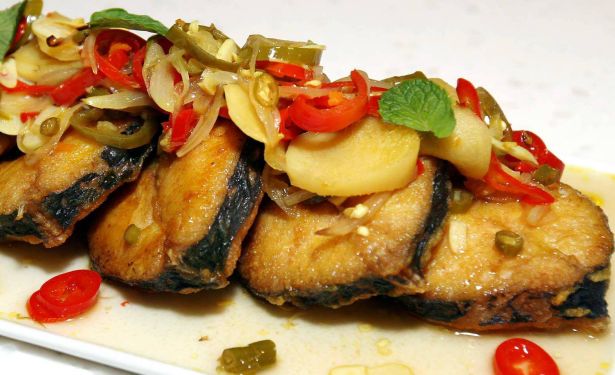Recipe Description
Steamed egg is one of the most basic dishes that is normally served in many Chinese households. It’s one of the first dishes that we become familiar with as children, and it has often become a comfort food as we grow into adulthood.
As simple as it is to prepare, I was surprised by the number of requests I got for the recipe of this dish. The trick in creating a velvety smooth steamed egg is to bring the water to a brisk boil before placing the egg on the steamer and to bring the heat down low once it is covered. Some people put a plate over the steaming dish to prevent condensation, but that is optional.
The egg batter itself is just a mixture of egg and water. You need to add in enough water so it’s not stiff, but not too much that it doesn’t set. A good ratio of egg to water is 1:1.5, meaning one and a half times the volume of water to the volume of the eggs. I find that the best way to do this is to whisk all the eggs in a measuring cup, and then just top up with the required amount of water.
Another trick in getting a smooth texture is to remove as many bubbles or foam from the mixture as you can before steaming. You can remove quite a bit by straining the mixture through a wire sieve and also try to pop any big bubbles that float over the top. There was even one YouTuber who placed a cling wrap over the dish to dissipate the bubbles as he steams his eggs. You may try his method but I find that it is quite unnecessary.
This recipe is called three fortune because it uses three types of eggs, namely chicken eggs, salted eggs and century eggs, and fortune is a transliteration of yolk in the Chinese language.
Many households would also incorporate minced pork or diced tofu into their steamed egg. For added flavour, some recipes also include sesame oil, soy sauce or chicken broth into the egg mixture, making it almost like chawanmushi.
Likewise for garnishing, my wife’s family recipe would omit the fried shallots and garlic and garnish the dish with just scallions and soy sauce. It’s the many variations that make this dish unique from home to home.
Recipe Ingredient
- 4 large eggs
- 2 salted eggs
- 2 century eggs
- ¼ tsp salt
- ½ tsp white pepper
- about 1½ cups water
- 4 bulbs shallots, sliced
- 4 cloves garlic, minced
- 4 tbsp cooking oil
- 1 sprig scallion, diced
- 1 red chilli, diced
- 1 tsp light soy sauce
Instructions
- Break the four eggs into a large measuring cup.
- Wash and clean off the charcoal and clay covering from salted eggs. Break the salted eggs and separate the yolks from the whites. Add the salted egg whites into the measuring cup.
- Measure the total volume of eggs in the measuring cup and add about one and a half times the volume of water to the egg mixture. Add salt and pepper to taste and whisk until combined, lightly so that you don't create too much foam. Strain this mixture through a wire sieve and pour into a heat-proof dish.
- Cut the salted egg yolk into small dices and add to the egg mixture.
- Wash and clean off the rice chaff and clay covering from century eggs. Remove shells and cut the century eggs into small dices. Add to egg mixture.
- Bring water to a boil in a wok with a steaming rack. Place the egg dish into the steamer and bring the heat down to low. Cover with a lid to steam for about 7 minutes until egg sets, with the centre still wobbly.
- Fry shallots and garlic in oil until lightly golden and crispy, then sprinkle over the steamed egg. Garnish with diced scallions and red chilli, and soy sauce to taste. Serve immediately.









